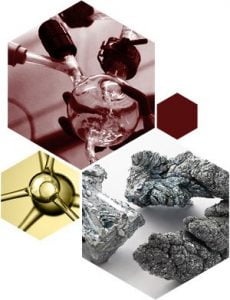
Cobalt (II) Chloride Hexahydrate
Properties
- We can offer items in bulk or custom. For other quantities or purities, please request a quotation.
- All prices are subject to change.
Information about Cobalt (II) Chloride Hexahydrate / CAS 7791-13-1
Cobalt (II) Chloride Hexahydrate (CoCl₂·6H₂O) is a versatile inorganic compound with significant applications in catalysis, materials science, and biomedical research. Known for its solubility in water and ability to coordinate with various ligands, this compound serves as a precursor in multiple chemical syntheses. Its distinct color-changing properties enable its use historically as a humidity indicator. Additionally, Cobalt (II) Chloride is useful for educational demonstrations to illustrate concepts like hydration/dehydration, color change, and transition metal complexation. Modern research has expanded its relevance to cutting-edge applications such as nanoparticle synthesis, catalysis, and electrochemical energy storage.
One primary application of Cobalt (II) Chloride hexahydrate is in the synthesis of cobalt-based nanoparticles, which have gained attention for their catalytic capabilities. Research has demonstrated that cobalt nanoparticles derived from CoCl₂·6H₂O serve as efficient catalysts in various redox reactions, particularly in environmental and industrial applications. These nanoparticles exhibit high stability and reactivity, making them valuable in the development of electrocatalysts for energy conversion processes. Cobalt-based catalysts also play an essential role in Fischer-Tropsch synthesis, aiding in the production of synthetic fuels and value-added chemicals.
In materials science, Cobalt (II) Chloride hexahydrate is employed as a precursor in the synthesis of cobalt-doped metal oxides, which have found utility in magnetic, optical, and electronic applications. Studies have indicated that Co-doped ZnO microcrystals synthesized using CoCl₂·6H₂O display enhanced optical properties, including improved photoluminescence, which is valuable in optoelectronic devices. These materials have also exhibited promising antibacterial activity, making them suitable for antimicrobial coatings and biomedical applications. Moreover, CoCl₂·6H₂O is frequently used in the production of cobalt-based metal-organic frameworks (MOFs), which are extensively researched for gas storage, separation, and catalysis.
Biomedical research has also leveraged the properties of Cobalt (II) Chloride hexahydrate, particularly in the development of cobalt-doped biomaterials. Studies have shown that cobalt-modified nanomaterials possess desirable bioimaging capabilities, with applications in fluorescence and magnetic resonance imaging. CoCl₂·6H₂O has been utilized in the synthesis of nitrogen and Cobalt doped carbon dots, which act as multifunctional nanoprobes for bioimaging. Additionally, Cobalt ions play a role in hypoxia-mimicking conditions, making this compound a valuable tool in cellular and tissue engineering studies.
Another significant application of Cobalt (II) Chloride hexahydrate is in electrochemical energy storage and conversion technologies. The compound serves as a precursor in the fabrication of cobalt-based electrocatalysts for water-splitting reactions, particularly in the oxygen evolution reaction (OER). Advances in electrode materials have shown that cobalt-doped materials enhance catalytic activity and stability in energy storage devices such as supercapacitors and lithium-ion batteries. The growing interest in sustainable energy solutions continues to drive research on CoCl₂·6H₂O-based materials for next-generation energy technologies.
The industrial sector benefits from Cobalt (II) Chloride hexahydrate’s role in metallurgy and ceramics. In metallurgical applications, Cobalt compounds act as additives to enhance the hardness and durability of metal alloys. The glass and ceramics industries utilize cobalt chloride as a colorant to impart blue hues to glass and enamel products. Furthermore, CoCl₂·6H₂O is used in electroplating processes to deposit cobalt coatings, which improve wear resistance and corrosion protection in mechanical components.
- Mahey, S., Kumar, R., Arora, R., Mahajan, J., Arora, S., Bhardwaj, R., & Thukral, A. K. (2016). Effect of cobalt (II) chloride hexahydrate on some human cancer cell lines. Springerplus, 5, 1-14.
- Nazarifar, M. R. (2014). Cobalt (II) Chloride Hexahydrate as an Efficient and Inexpensive Catalyst for the Preparation of Biscoumarin Derivatives. Advances in Chemistry, 2014(1), 340786.
Safety
- H302 Harmful if swallowed.
- H317 May cause an allergic skin reaction.
- H334 May cause allergy or asthma symptoms or breathing difficulties if inhaled.
- H341 Suspected of causing genetic defects.
- H350 May cause cancer.
- H360 May damage fertility or the unborn child.
- H410 Very toxic to aquatic life with long lasting effects.
- P201 Obtain special instructions before use.
- P202 Do not handle until all safety precautions have been read and understood.
- P261 Avoid breathing dust/fume/gas/mist/vapours/spray.
- P264 Wash skin thoroughly after handling.
- P270 Do not eat, drink or smoke when using this product.
- P272 Contaminated work clothing should not be allowed out of the workplace.
- P273 Avoid release to the environment.
- P280 Wear protective gloves/protective clothing/eye protection/face protection.
- P284 Wear respiratory protection.
- P301+P312 IF SWALLOWED: call a POISON CENTER or doctor/physician IF you feel unwell.
- P302+P352 IF ON SKIN: wash with plenty of soap and water.
- P304+P340 IF INHALED: Remove victim to fresh air and Keep at rest in a position comfortable for breathing.
- P305+P351+P338+P310 IF IN EYES: Rinse cautiously with water for several minutes. Remove contact lenses, if present and easy to do. Continue rinsing. Immediately call a POISON CENTER or doctor/physician.
- P342+P311 IF experiencing respiratory symptoms: call a POISON CENTER or doctor/physician.
- P363 Wash contaminated clothing before reuse.




